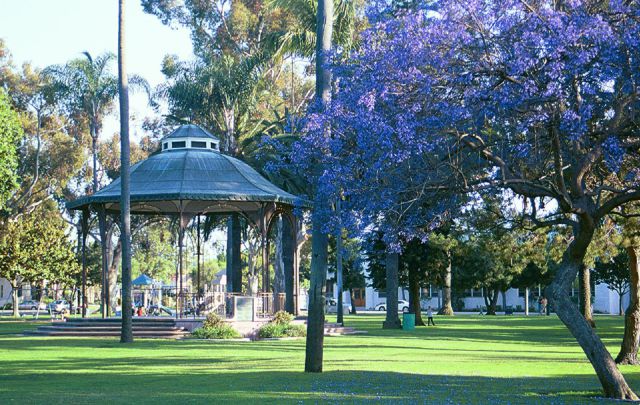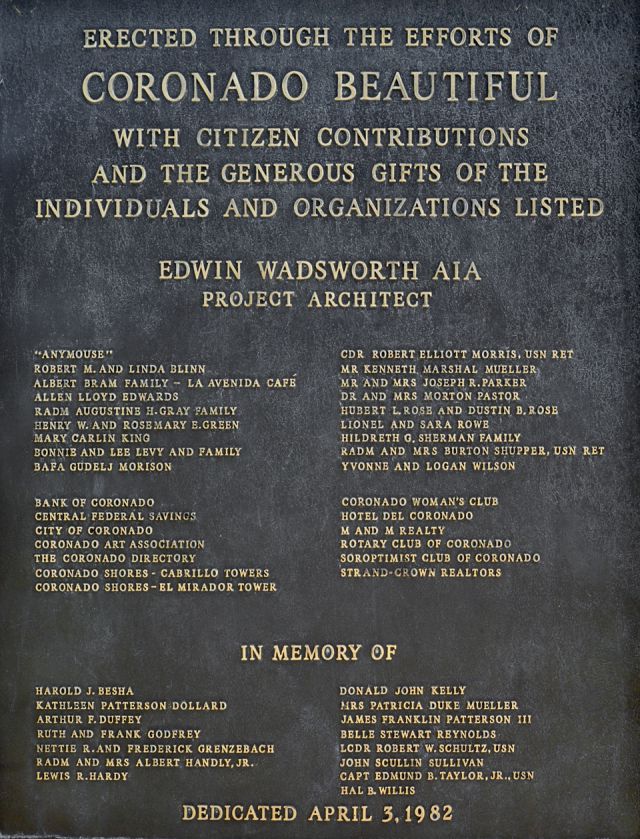In Concert
Community came together to raise funds for construction of Spreckels Park Gazebo
Dedicated in 1982, the gazebo is a testament to the people of Coronado’s love for their community. The idea for a bandstand started nearly 10 years before the structure was finished.

Photo Credit: Discover Coronado
In 1973, the Soroptimist Club of Coronado decided to get a bandstand pavilion built in Spreckels Park in time for America’s bicentennial celebration in 1976. Toni Hoppe was president of the club that year, and she became one of the key figures in seeing the project through to the end. “This was something that was very dear to her. She wanted to see it constructed, and she thought it was a great idea early on,” said David Hoppe about how important the project was to his mother.
Local Philanthropy and Matching Funds
By February 1975, local philanthropist Barney Padway offered to give matching funds for the project, up to $6,000, in the hope that the project would pick up momentum. That prompted the city of Coronado to offer the same amount. Padway was anxious for the project to start.
He was 90 years old and said in a story in the Coronado Journal he wanted to see the project completed “while I’m still around.”
The Soroptimist Club of Coronado paid for preliminary renderings, and the City Council approved a five-member committee to study the pavilion’s design, siting and cost.
The committee consisted of Padway and a representative each from the city, Soroptimist Club, Coronado Floral Association and Coronado Beautiful, a civic organization, established in 1971.
Construction Begins in 1981
The project ended up being a much bigger undertaking than the Soroptimists were able to manage. So in 1977, Coronado Beautiful took over as lead, with Hoppe from the Soroptimists joining the committee to help raise funds.
By 1980, a thousand people had donated more than $40,000. The committee announced that donors of $1,000 or more would be memorialized on a permanent plaque affixed to the pavilion.

Concerned citizens raised doubts about the removal and relocation of some of the palm trees in the park. Michael Rutter, president of Coronado Beautiful, defended the project and on Nov. 7, 1980, the California Coastal Commission approved the plans for the bandstand.
The permit request was for the construction of an octagon-shaped, 26-foot-wide pavilion with a 44-foot-wide octagonal cement base and a 30-foot-high copper dome roof and cupola.
Bids came in at $65,000, so the city kicked in the extra $10,000.
Construction began in June 1981. By August, the copper roof was completed and Bud Bernhard, a local bricklayer, laid the cement for the base, donating his services. A time capsule with names of all the donors was placed in the foundation. Members of Coronado Beautiful are commemorated on a round plaque in the floor of the gazebo, which is also the cap of the time capsule.
At 2 p.m. on April 3, 1982, the pavilion was dedicated, and Mayor Pat Callahan accepted the bandstand on behalf of the city of Coronado from Coronado Beautiful. The Mesa College Community Band performed, and it was announced that the pavilion would be available for concerts, weddings, plays and other cultural events.
“We knew that we were working on something special, and this outpouring of support just reinforced that fact for us. I am sure all the members of Coronado Beautiful are proud of what we accomplished. I know I am,” Rutter stated when the gazebo turned 20.
Toni Hoppe was also pleased. She was “immensely proud of what the community did, putting it all together,” her son said.
And Padway, who died in 1986 at the age of 101, got to see the completed gazebo.
